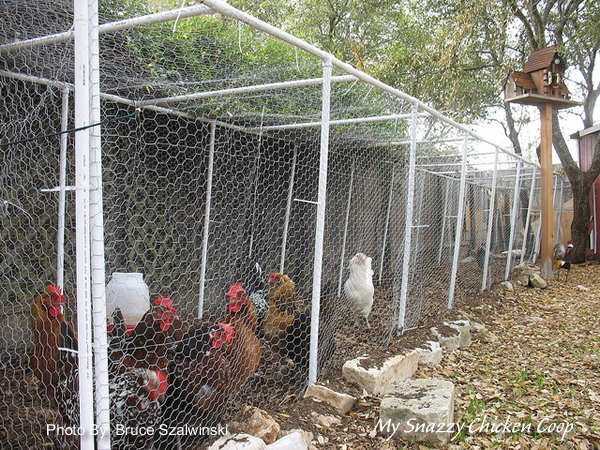Chickens love to scratch and peck – it’s what they do. They will love to be outside pecking around for bugs etc if they get the chance to and unless the weather is really bad, or they are laying an egg, most would choose to be outside for the majority of their time. In small gardens and backyards free ranging all day is often not possible (unless you don’t mind them taking over your whole garden and eating/scratching up everything in sight). From a predator safety point of view gardens are often not secure enough to be predator proof (it is not even necessarily things like foxes and hawks that do the most damage – neighbourhood dogs can be a real menace) and your chickens may travel into other neighbours yards. To keep them secure a run is needed. Allowing at least 10 square feet for every chicken is usually recommended – especially if they are to be in there all of the time. Building a run for your chickens is fairly simple – a simple run could be constructed from a wooden frame or even pvc piping with small holed galvanised steel wire attached to it.

Here are some things to consider :
1. Protection : A run needs to be secure so that predators such as foxes, neigbourhood dogs, hawks, racoons, rats etc. can’t get at your chickens. ‘Chicken Wire’ for your run may seem the obvious choice but can be easily bent or bitten out of shape so for the best security small holed galvinised steel wire would be better. Small holes help prevent predators such as racoons reaching through and grabbing a chicken through the wire (many have lost a leg – or worse – in this way). Having the wire continuing down a little underground and out a few inches will help prevent diggers from burrowing in. Having wire over the top of your run will stop hawks from swooping in (or other predators climbing over).
2. Height : Many chicken breeds can fly over a 5 or 6 foot fence so having wire over the top will also help stop them getting out. From an access point of view, it will be much easier for you to tend to your chickens if the run is a height you can stand up in.
3. Mud : The grass in my chicken run lasted about two months before the whole area became just mud, and they were only in the run for a few hours a day. Chickens scratch and unfortunately, unless they have such a large area so their effect on it is spread out that much more, a grassy run will end up as a mud one very quickly so drainage is important.
4. Shelter : Try to make sure they have areas that are shaded from the sun, and can shelter from the wind and rain.

5. Stationery vs. Portable Runs : A stationary run will probably benefit from some kind of ground cover – common chicken run ground cover options are things like pine chips, straw, and sand. You can build or buy portable coops and runs called ‘chicken tractors’ or ‘tractor runs’. They tend to be quite small (less than the 10 square foot normal allowance of space) but are moved frequently to a new area which gives the previous area(s) time to recover in between, and the chickens a new ‘clean’ run.


Join the Discussion!